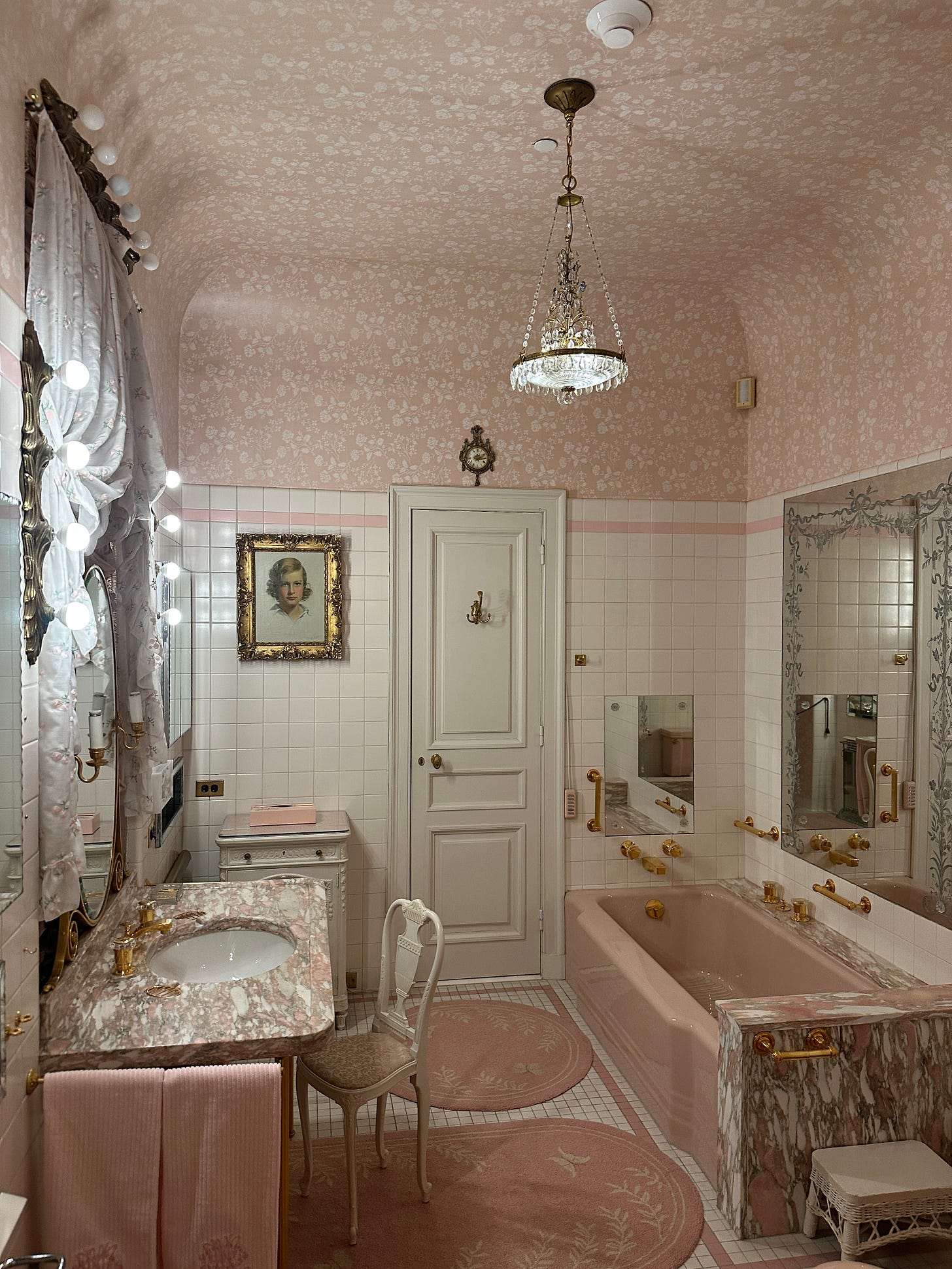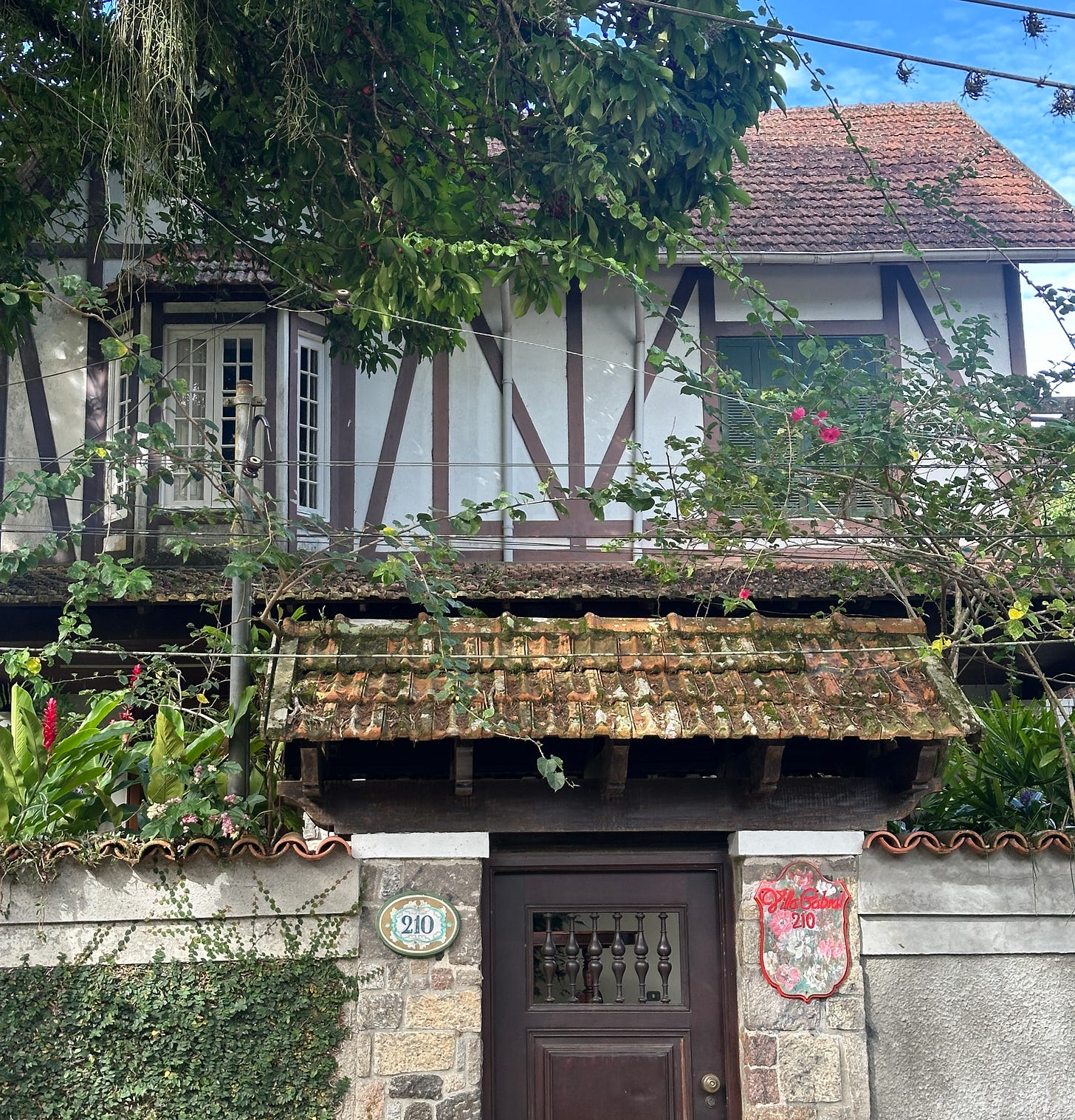'I Killed the Wrong Architect'
Plus, Uber's new scammy policy, exoskeletons for hiking, and Mykonos as a risky hotel bet.
Despite years of terrorizing boys and girls worldwide, it was the cold-blooded murder in 1906 of architect Stanford White that made the violent playboy Harry Thaw almost face justice. That brazen crime cut short the life of one of the most talented architects ever, albeit one with his own demons. Years later, while gazing upon Mar-a-Lago—the Palm Beach mansion built by the richest woman in America, Marjorie Merriweather Post, and now owned by President Trump—Thaw is said to have exclaimed, “Oh my God, I killed the wrong architect!”
I was reminded of this likely apocryphal Thaw tale1 last week when I popped by Post’s Hillwood Estate in Washington, D.C. for a small new exhibition on her legendary yacht, Sea Cloud.
Hillwood was just one piece of Post’s staggering array of nearly a dozen houses as well as a private train car, a plane, and yachts. Along with Mar-a-Lago and Hillwood, Post’s other notable homes were a 54-room triplex on 5th Avenue and Camp Topridge in the Adirondacks. With her vast fortune, Post also accumulated one of the most impressive collections of jewelry and decorative objects in the world. Her plundering of Russia2 after the fall of the tsars was particularly effective, and Hillwood is full of Fabergé objects (including two eggs), precious Russian art, and historic pieces.
Now a house museum, it’s one of the more enjoyable sights in the capital outside of the main attractions. The neo-Georgian mansion is a time capsule, with many of the rooms straddling the tastes at the end of the Gilded Age with the less and less fusty preferences of the 50s and 60s. A universal favorite is the “Mamie pink” bathroom. Found just off Post’s French antique-filled bedroom, the bathroom captures the blending of styles here better than anywhere else. Plus, it’s awash in the color made famous by First Lady Mamie Eisenhower.
Post is sort of an odd figure in American social and business history in that she’s relatively unknown compared to her contemporaries. She may have been as big of a jewelry collector as fellow District socialite Evalyn Walsh McLean, but it’s hard to compete with the Hope Diamond and McLean’s tragic life. While she suffered through her share of marital woes, none were as epic as those of Consuelo Vanderbilt. Post never had the scandals of Doris Duke or Barbara Hutton (Post’s one-time niece), or the star-wattage of Babe Paley. And despite being by all accounts a very astute steward of the General Foods conglomerate, cereal and frozen foods aren’t as memorable as owning papers and magazines like Katharine Graham.
But Mar-a-Lago’s current prominence and the Hillwood Estate have ensured she remains part of the cultural lexicon.
While small, this little exhibit on Sea Cloud in the estate’s dacha (until June 15) is worthwhile if for no other reason than we’re living in a renaissance of sailing mega-yachts. And Sea Cloud is a behemoth, clocking in at 359 feet. It was the largest sailing yacht in the world for decades. But it was a lonely crown, as it wasn’t until the 2000s that some of the wealthiest people in the world set aside their obsession with power yachts and seek the distinctiveness that comes from sailing vessels. A, Koru, Black Pearl, Eos, Athena, Maltese Falcon, Aquino, and MV5 have all been built in the last 20 years—and only A and Koru are longer than Sea Cloud. Sea Cloud is now a cruise vessel, and though restored, I’ve been told it’s seen better days.
Like much with Post, Sea Cloud is impressive—four masts, ornate staterooms, the heft of a ship of the line. But my personal take (don’t be mad Hillwood staff and lovers!) is that she lacked an appreciation for subtlety and charm. For instance, the rooms at Hillwood have treasures that would make a connoisseur of 17th and 18th-century French furniture drool. But the impression is of a collection, especially when you contrast it with something like Duke’s Rough Point which feels so personal and idiosyncratic. It’s fitting, perhaps, that Post loved so much of the Russian royal family’s objects, given the Romanov tendency for taking Western European architecture and designs to their most expensive extremes. The over-the-top theatricality of Mar-a-Lago shocked even those who had seen the excesses of the Vanderbilts.
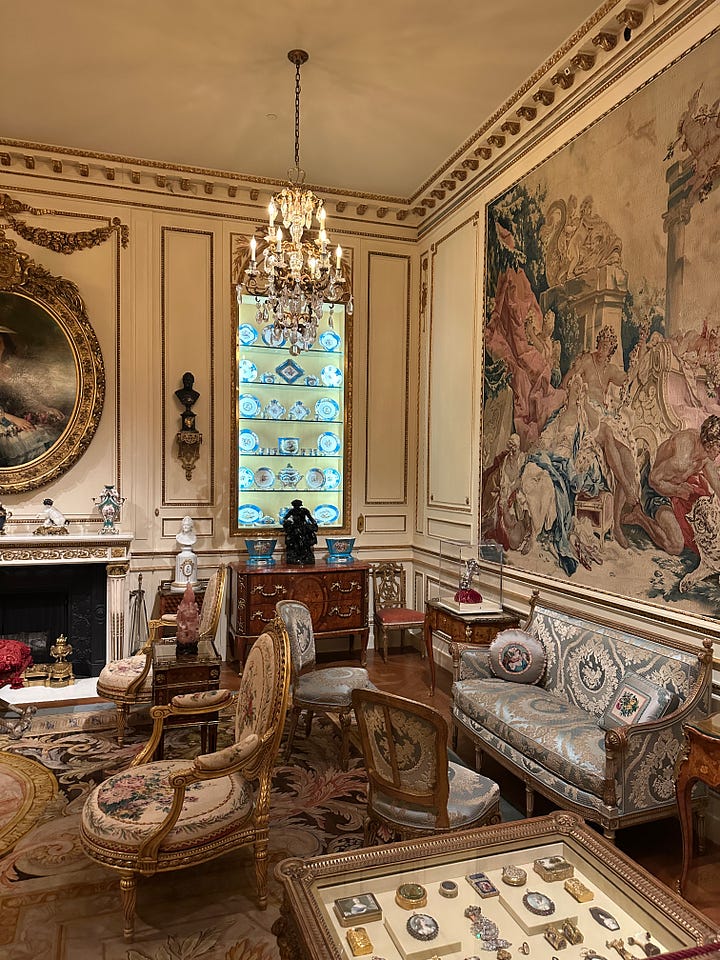
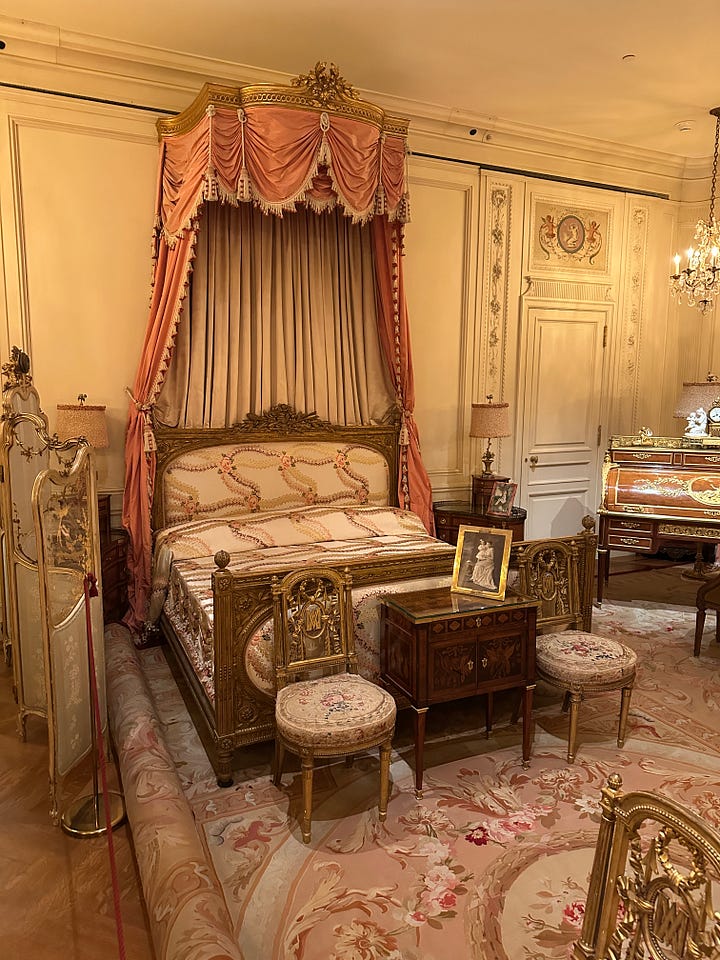
None of my judging Post’s particular tastes should deter you from touring Hillwood. The fact is that her collection is remarkable. In visiting it you will see a treasure trove of decorative objects from around the world with which any king or queen would find it hard to compete. Everything is immaculately maintained and docents are brimming with anecdotes and information for the inquisitive. The gardens are elegant and make for a delightful spring or fall visit.
And for the hour or two that you walk its grounds, you can disappear into that classic question—“What would I buy if money was no object?”
I took advantage of the holiday weekend last week to take a quick break from newsletter work and go to New York City to check out The Manner. It’s the first outpost of Standard Hotels’ new luxury brand. (The StandardX is their other new budget-friendly brand for younger folks.) The Manner surprised me in several ways. While its decor is LOUD (like the lair of a 70s Bond villain in love with marigold) the hotel itself is astoundingly quiet. It’s a rarity in New York, let alone in Soho. And while the main restaurant The Otter still needs some work, I loved hanging out in its guests-only lounge The Apartment where drinks, breakfast, and snacks are included in your stay. It was a nice perk to be able to invite a friend or two for a couple of glasses of wine in this cozy yet dramatic space. Oh and, yes, the chicken nuggets at Sloane’s, the hotel’s speakeasy, lived up to the hype. (The drinks very much hit the spot as well.)
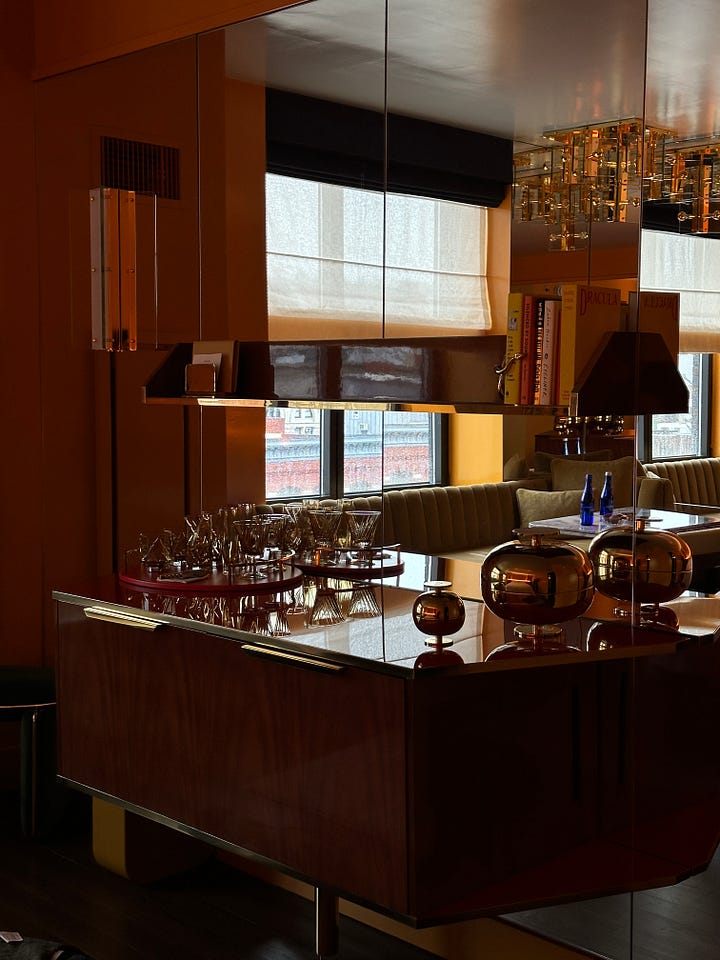
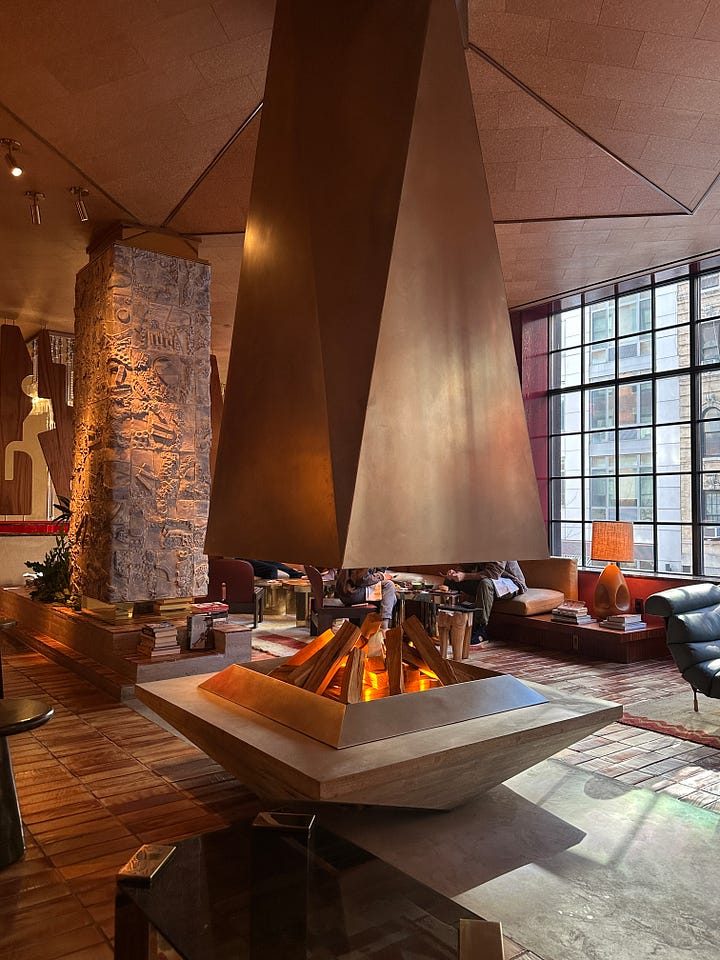
DEPARTMENT OF GRIEVANCES
A couple of weeks ago, BILT sent out a survey to customers. For the unfamiliar, BILT is the popular travel credit card that has no annual fee and awards extra points for using it to pay your rent. It is immensely popular. So popular, in fact, that Wells Fargo (the card issuer) was reportedly losing boatloads of money every month on the card. In its survey, BILT hinted at something that everybody who has been around for the last decade should have seen coming—fees. We’ve all seen this cycle. Something cool and innovative and genuinely useful is introduced but it doesn’t make actual money. And so after hooking everybody or knocking out competitors, it starts to become like every other business with fees and restrictions and so on. Who knows what will happen with BILT, but it seems like if/when it introduces tiered cards, the no-fee card will be less and less valuable.
When I lamented a few months ago the demise of “over the wing” jet bridges that allowed front and rear boarding and deplaning, I didn’t mean to encourage more buses. I just meant that a lack of creativity when it comes to utilizing both the front and rear exits is at the heart of one of the more painful points of air travel. But more bus usage is the logical outcome of the announcement this week from Frontier’s CEO that jet bridges are the “kiss of death” and that the airline wants to rely more on ground loading to board and deplane from front and back. Ugh.
Speaking of painful points of air travel, going through security again when connecting at an international airport is so annoying. If we trust security in Paris enough for that plane to land here, what could I have done while in the air to become a threat? Well, some small but good news on this front was announced this week. American Airlines and Heathrow Airport are taking part in a pilot program that will allow American passengers flying from Dallas to connect at Heathrow without going through security again. It’s only for passengers from Dallas, but as anybody who has had to go through the very annoying British airport security, this is welcome news.
On my recent trip to Brazil, I went for a hike in the jungle outside of Rio. The meetup point was this little village square made up of wattle and daub Tudor Revival houses and apartment buildings. While swatting away relentless mosquitos it hit me that Bhutan might be the only country I’ve ever been to where I didn’t come across a Tudor Revival house. It’s sort of astounding the chokehold this romantic and, frankly, silly style had on the globe, especially in the early 20th century. Was Anglophilia that widespread? Did everybody want to live in a dark house?
Washington, D.C. has never had a Soho House, and its private club offerings are pretty much the same as they were a half-century ago. (HBO’s White House Plumbers had a fun rundown on what type of person belonged where, most of which remains true today.) So it was a bit of a surprise but also totally logical when The Ned announced it was opening an outpost here. Created by Soho House co-founder Nick Jones and current Soho House owner Ron Burkle, The Ned has locations in London, New York, and Doha. The Washington, D.C. outpost is on the top floors of a building around the corner from the White House next to the Milken Institute. Its outdoor terrace and dining rooms have sweeping views of all of the major monuments, the White House, and the Treasury Building. And so in some ways, the location is unbeatable. You don’t get these kind of views elsewhere. But it’s also a funny location because, for city residents, this area is sort of a dead zone. One of the nice things about D.C. is that the areas tourists congregate—the Mall, Federal Triangle, M Street—aren’t areas people live in. So it’s sort of a ghost town at night.
Some friends kindly took us this week to check it out and the spaces are generally pretty nice (although the artwork is quite bad) with those unbeatable views. Food was fine and the drinks very good (no surprise there as they poached from Silver Lyan). But I will say the crowd was old. Like, if you were in your early 40s you were one of the younger people there. That’s perhaps because of the cost—$5,000 a year with a $5,000 initiation fee. And that D.C. industries don’t lend well to mixing of ages like in LA and NYC. I do think, however, as it starts to warm up that might change because the terrace is very well done.
I enjoyed the Wall Street Journal profile of Tristan Schukraft, the entrepreneur who has bought up the commercial district of Fire Island Pines as well as other gay hospitality venues. I particularly appreciated that it didn’t shirk or get prudish about details that papers historically have when it comes to gay subjects. However, I really, really, do not like the name of the hotels—Tryst.
If you’re ever abroad and asked by a cashier handing you the machine whether you want to pay in the local currency or dollars, always select the local currency. That’s because most cards in the U.S. don’t charge foreign transaction fees. But there are often hidden fees charged to have it converted by the processor and a good chance you’ll get a worse exchange rate than your bank or card company would. Well now Uber wants in on those fees, and starting this week in the U.S., EU, and UK, is changing the settings on its app to show fares in your home currency with a fixed 1.5 percent fee. If you want to prevent this rip-off (and you should), you’ll need to go into your settings and turn off currency conversion.
One of the more formative cultural episodes of my childhood was the steroid crisis in baseball. It’s hard to fathom now, but the hysteria around performance-enhancing drugs got so large that congressional hearings were held. (I’m still shocked by hearing Sammy Sosa talk out loud.) So I have all sorts of conflicted feelings about sports and what counts as cheating. All of which surfaced when I read the story about robotic exoskeletons being used to hike difficult trails in China. My first instinct is that it’s cheating and, well, there go some of my favorite hikes that aren’t jam-packed because of their difficulty. But I also have older members of my family who can no longer join me on hikes like they used to, and these contraptions might change that. Is the hike more about besting something challenging? Or is it more about getting to enjoy the natural world?
I’ve mentioned it before, but in case you needed a reminder after the Delta/Toronto flight incident. Put. On. Your. Seatbelt.
Oh gosh, I could so get on board with broken windows policing that focuses on this issue. In France, a man was fined $200 for talking on speakerphone in a train station.


While the reconstructed historic center of Warsaw will always seem a bit odd to me, I fell in love with the city when I visited half a decade ago. The POLIN Museum of the History of Polish Jews is hands down one of the top three museums I’ve ever been to. Adding to its allure is what many consider the most exciting museum opening of 2025, the Museum of Modern Art Warsaw, which as of two days ago is completely opened with its inaugural exhibition: The Impermanent: Four Takes on the Collection. Designed by Thomas Phifer, it’s a startlingly white complex next door to Stalin’s Palace of Culture & Science. I can’t wait to see it in person.
The report put together by the U.S. Travel Association on the state of the U.S. travel market and what needs to change is a sobering document. (U.S. market share of international travel in the last ten years has dropped nearly four percent.) Massive events are coming here soon: World Pride, the World Cup, the Olympics, the U.S. turning 250, and more. And yet from Air Traffic Control to Border Patrol to TSA to embassy staffing, the U.S. appears woefully unprepared. It remains to be seen how seriously their report is taken, but it’s well worth reading if you care about the future of the U.S. as a destination and our image to the rest of the world when they visit.
Props to Colin Nagy and Skift for calling out folks who worry about over-tourism turning around and covering White Lotus tourism in Thailand. I’m not sure where I fall on this—a lot of media is giving people what they want and people very much want to travel based off White Lotus. But it’s good to see something other than fluff in travel media and an article with a bit of bite!
Why do people bother going to Venice anymore…
This is absolutely wild. A hot air balloon company in California offers rides where you can get it on with your partner in the sky. The pilot will wear protective ear gear so they can’t hear anything and there is a partition giving you privacy. I can’t decide if this is genius or if we’ve lost the plot.
I’m skeptical but hopeful that the high-speed rail announced by Justin Trudeau will happen any time soon. Called Alto, it will theoretically stretch from Quebec City and Toronto with speeds of 300 km/hr. The Anglophone world is just so, so, so bad nowadays at building infrastructure.
Which makes me especially skeptical of the announcement from EuroStar that they want to expand to more parts of France as well as Germany and Switzerland.
And finally, it could be a risky but effective bet to have this be the spring or summer you go to Santorini. The earthquakes are still roiling the island, and bookings have flatlined. Normally, I find it all an absolute misery visiting here, but if the earthquakes suddenly stop and you’re there without crowds it could be nice…
TRAVEL INDUSTRY NEWS
Accor’s CEO says opening a hotel in Mykonos is too risky due to climate change
You have until August 31 to see the Bayeux Tapestry before it goes out of public view for two years
And until the end of summer for the Centre Pompidou, which will close for five years
The Neiman Marcus flagship in downtown Dallas is closing
Bankruptcy court approves Spirit's reorganization plan
You’ll soon be able to redeem AAdvantage miles on South American carrier JetSmart
Emma Chamberlain opened a cafe in Los Angeles. Is it any good?
Albufeira in Portugal is the latest to adopt a ‘bikini ban’
This same tale has been used for Grauman's Chinese Theatre, among others
all legal





